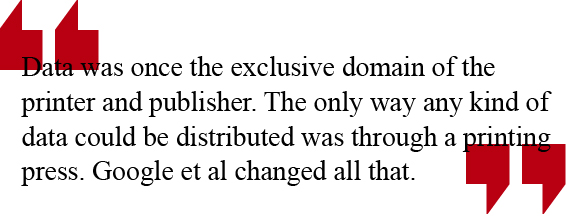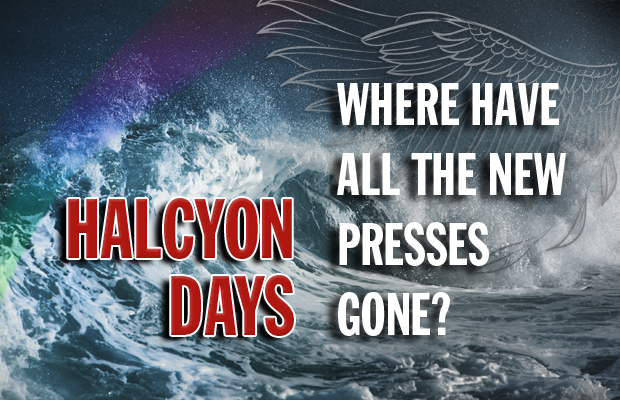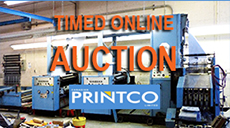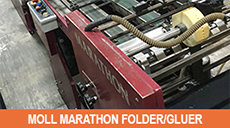"Those were the days, my friend, we thought
they’d never end . . . " The song popularized by
Mary Hopkin in 1968 waxed over youth, lost
opportunities, passions and a life now well past its prime.
Cycles of every form have a beginning as well as an end.
Technology breeds new revenues and fills scrapyards with
redundancy. For the printing machinery industry, there
is a lot of reminiscing about good times back in the day.
The great period of litho printing press sales, what almost
became an annuity business for press makers, is long over
and will not return. Oh how painful it is to say that.
It seems like only a few years ago we were so excited
to embrace a device that, either by violet or thermal laser,
entirely eliminated a labourious step of the production
cycle and make offset plates perfectly, without fit issues,
and at incredibly fast speeds as lasers advanced by the
month. Digital technology was our friend. Prior to CTP,
the Macintosh computer also eliminated a huge chunk of
the typesetting industry by letting us do it all ourselves.
Fantastic new devices were going to rid us of waxers, light
tables, film, cameras, plate-makers and a great deal of expensive
labour. Everybody knew that strippers and other
prepress employees commanded large paychecks. Wasn’t
this future fabulous?
As I look back at some of the projects we were involved
with at Howard Graphic Equipment, I find that no one really
had any idea of where mobile computing, particularly
the smartphone and tablet, would take communications.
We once had a customer who had a rather simple contract
to print a 10-point cover and then stitch it onto popular
magazines. It was for a now-defunct airline, to be used on
the aircraft. The airline wanted to ensure these magazines
were returned and so had produced the magazine with
its logo emblazoned on the false cover. In time, the costs
proved too high and the airline asked instead for a sticker
to be tipped onto the cover. Finally, the magazines as a cost
were dropped altogether.
Another customer produced a weekly sports betting
card. These were perfected one over one and printed in
the millions. Again costs and technology overtook print
and now all the betting is online, no day-changing betting
cards, just a receipt with the details.

In the early 1980s, we did quite a lot of business with
an accounting publisher. Every time there was a change
in Canada’s revenue act new sections had to be printed.
Even then hot metal Linotypes were used to make copy.
It was proofed and then film and plates were made to run
on a web. The bindery was enormous to handle the accounting
publisher’s work. It had separate lines for side
stitching, hole punching and perfect binding. The annual
tax-code book was almost two inches thick and expensive.
Accountants, who were members, bought special binders
for all of the inserts of changes that would occur each year.
The Internet almost overnight eliminated all of this mechanical
work and hundreds of jobs.
Many printers found themselves in the same situation
with legal books and court decisions. Changes in the law
created a great deal of print and case-bound work.
Think of the law offices up until recently, where huge
libraries stored the requisite purchases for dozens of sets of law books. If not annually mandatory,
dozens of new thick books spoke to a law
office’s prestige Automotive manuals and
parts books were a staple of a few of our
customers, too. In the turn of just a few years,
almost all are now out of print entirely.
In the early 1990s, my company Howard
Graphic Equipment purchased a Miller
perfector from a printing company in
the east of England. This firm had a long
history. They were ensconced in what had
been a carriage house, even had an 1800s
workable water closet. The biggest piece of
business for this printer was railway timetables.
Almost all of it is now redundant.
A smartphone can look-up the schedule
and buy a ticket to ride without any paper
being expended.
Wondering where all of the presses have
gone is an intriguing question. In a commendable
open manner, KBA in its latest
annual financial statements for 2013 approached
this difficult subject. KBA commented
that group sales had slumped 35
percent since 2006. Since KBA is heavily
involved in both sheetfed, web and special
presses (currency and metal decorating),
it has an almost split revenue business at
€571.9 million for sheetfed and €527.8 million
for web and special presses. KBA also
acknowledges that since 2006 its Web sales
have fallen 70 percent and sheetfed almost
50 percent. The statements also comment
that the Web business will continue seeing
retraction in the coming years. Should we
assume KBA, although heavily diversified,
is an example of what all major press makers
are going through? The answer is yes.
Competitors to KBA may argue that
the business of newspaper printing (long
a staple of KBA) exacerbates the drop in
sales. They may also suggest that perhaps
KBA had a smaller commercial and publication
customer base, or that what KBA
produced was not as suitable? But KBA
is a major supplier in both fields. On the
sheetfed side, KBA owns a major position
in packaging and Very Large Format
sheetfed printing. New in-roads in technology
have been poured into the Rapida
106 and 145 platforms. One surmises
with its packaging strength KBA’s only
real rivals are Heidelberg when it comes
to imaginative, multi-purpose machinery
for the carton industry. Komori and Manroland
also compete in this segment with
Manroland running a close third to KBA
and Heidelberg in press variants.

We as a machinery segment are a reflection
of you the printer just as you are
a reflection of your clients. Therefore. we
must assume printers cannot make the
math work when calculating return costs
for a large piece of machinery. Presses that
cost a million dollars plus are no longer
the prime piece of manufacturing gear
in a printing business. They may never
be again. There are exceptions of course.
Trade printers who do it cheaper, not better,
may consider new machines. Packaging
printers will because the business is
stable. Smaller commercial printers, however,
will not. They may buy used, but its
doubtful that a majority of shops can draw
enough profitable work to pay for today’s
engineered marvels.
Data was once the exclusive domain
of the printer and publisher. The only
way any kind of data could be distributed
was through a printing press. Google et al
changed all that.
 |
David Carr, writer for The New York
Times, does a masterful job explaining
how the trend from a physical method
(newspapers) to online is humbling.
During a recent speech in Vancouver, Carr
eluded to this fact when explaining the
state of his employing newspaper. It was as
much funny as it was sad for those of us in
the business. He explained newspapers are
offices where everyday information comes
in and is collected. Then a bell goes off and
everyone stops collecting news and starts
to write down what came in that day. They
send the copy to a giant press where it’s
printed, rolled up and eventually thrown
onto your front lawn.
Carr accepts the inadequacies of news
distribution via print while at the same
time considering that large dailies like The
New York Times seem to be weathering
the storm and seeing growth via online
pay-walls. Carr hastens to add that it’s the
medium-size papers suffering the worst,
while small local papers, for the most part,
continue to do well in the communities
they serve. News is data and so is almost
every piece of information we need, which
used to be mailed to us. First Gutenberg
and now the colloquial Google has
changed our world again.
|
David Carr speaks at the PuSh International Performing Arts Festival at Capilano University, in North Vancouver, BC.
Photo credit: "David Carr 2013" by Ian Linkletter
|
Despite the odd period of increased
new machinery order intake that prevailed
in late 2013, the industry at large will not
go shopping for new litho machines again.
While I have a vested interest, few press
makers would argue the second-hand
press business becomes more important
to lessen a printer’s investment risk. It is
not coincidence that used machines now
are a much bigger piece of the machinery
trading pie than ever before in the history
of printing or that most press makers now
have full-scale used press operations.
The 50 percent machinery sales shrinkage
in seven years, as reported by KBA, is
reality for every litho press maker. Postal
rates and other fixed costs are impediments
that cannot be overridden with
faster machinery costing millions of dollars.
Where have all the presses gone? Nowhere
it seems.
|











